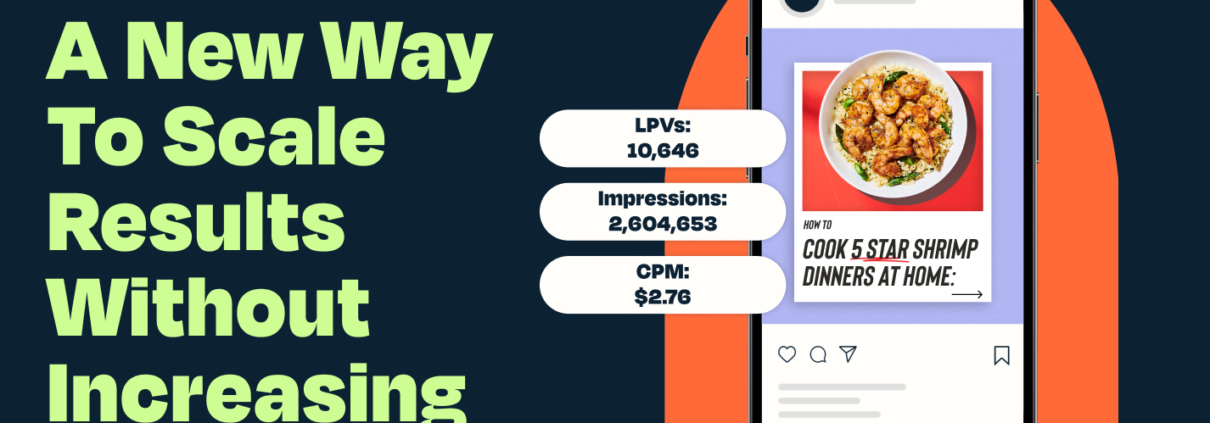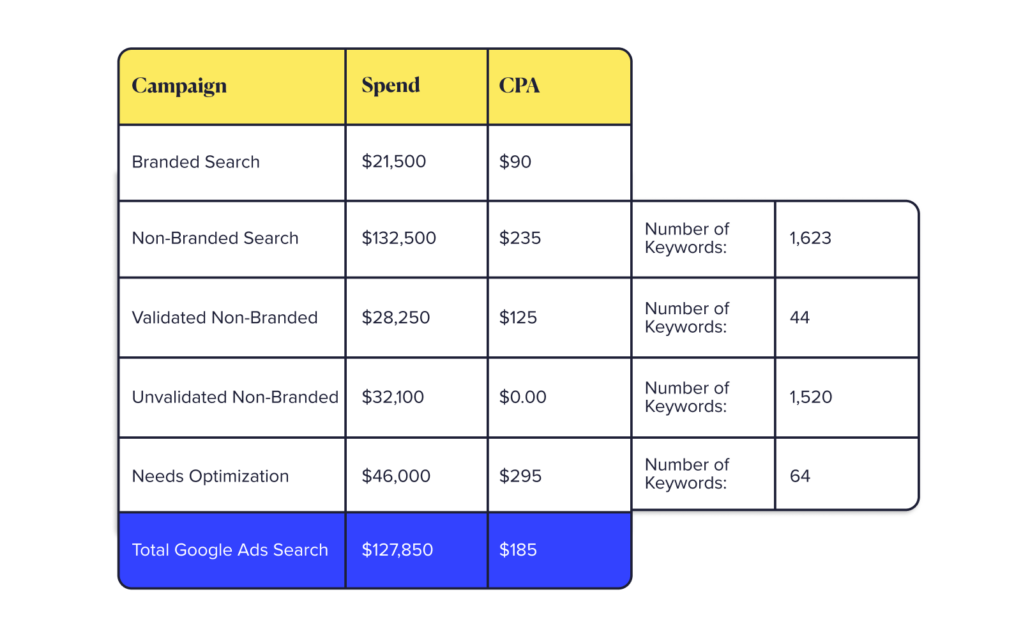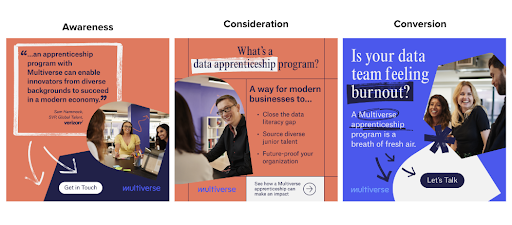A New Way to Scale Results Without Increasing Ad Spend
We’ve all had to do more with less with something at one point or another – whether it’s time, resources, or budget. Doing more with less is intrinsically part of the growth process. We get more efficient, and that creates a new benchmark that we need to meet or exceed the next go-around.
If you’re reading this, you’re likely a marketing leader feeling pressure to generate the same or more total results with less total ad spend. Why is that? And more importantly, how the heck do you manage to pull that off? Let’s dig in.
Why Marketers are Being Asked to Do More With Less
Since April 2022, growth marketing as a concept has been flipped on its head. Growth in pre-2022 terms, as defined by most marketers, would be the practice of scaling results as quickly as possible to maximize total results.
Often, the scaling was done at break-even CACs, or at a loss with the hope that the LTV of a newly acquired customer would eventually offset the cost of growth and fuel another round of funding.
In mid-2022, recessionary fears began looming, and skyrocketing interest rates caused inflationary pressures to mount.
As a result, most scaleups and enterprise brands have since had to adapt their growth strategies and models to do more with fewer paid resources. Performance marketing managers are feeling pressure from their CMOs to optimize for efficiency over volume, and CMOs are feeling pressure from CFOs to reduce spend as much as possible.
But… why?
For scaleups, a fear of uncertainty in venture capital markets caused organizations to create as close to a positive cash flow rate as possible to ensure they can keep the lights on for as long as possible.
For enterprise brands, the choice is often between growth and headcount. CFOs are trying to maximize the total human resources available to the organization (as it makes fiscal sense) while balancing paid growth. As a result, paid media budgets for both enterprise and scaleup brands are under direct scrutiny.
Cue the scramble to redefine what growth means.
If I’m a CMO that is being asked to hit growth targets (my job depends on my ability to hit them!), and I’m working with fewer resources, I need to make every dollar count. Growth at all costs is no longer the philosophy: creating sustainable, holistic growth is my new path forward.
Table of Contents
- Creating frameworks for sustainable paid growth
- Getting the most out of non-branded search
- Developing ad creative that forks for all parts of the funnel
- Targeting the same audience with different campaign optimization events
- Optimize the UX for traffic you’re already paying for
Creating Frameworks for Sustainable Paid Growth
If you’re in this situation currently, the good news is that you’re not alone. As a growth marketing agency, the large majority of our partners (90%+) have been tackling this same question over the last year and change.
We get it, budgets aren’t increasing anytime soon, and you have to make the most of every dollar to continue to grow results. So let’s dive in on how to do that.
We’ve created several frameworks for creating sustainable paid growth that can be adopted individually or in tandem with other growth strategies to maximize your ad dollars as much as possible.
- Maximize non-branded search
- Develop ad creative that works for every part of your funnel
- Utilize content in multiple optimization events
- Optimize the user experience for the traffic you’re already paying for
- Convert more leads with lifecycle marketing
Get the Most Out of Non-Branded Search
Paid search presents a huge opportunity for scaling for established brands that have some form of brand recognition and a clearly defined service or product that fits neatly into the search landscape. Search is high-intent because it’s action-oriented.
When bidding on a term, you know that you’re showing up in a placement where someone is showing some form of intent for seeing a result similar to what you’re targeting. Additionally, non-branded search typically takes up most of your paid search budget, so tweaking your philosophy on non-branded search is an easy way to make significant changes to your bottom line.
Because paid search is constantly evolving, staying on top of trends is important, but creating a testing framework to validate what works in your strategy should be a part of your evergreen approach. A methodology of “throw a bunch of keywords to the wall, see what works, and go from there” isn’t going to cut it.
There are two components to getting the most out of non-branded search:
- On established non-branded terms that drive revenue, maximize impression share
- For non-validated non-branded terms, dedicate a part of your budget to testing and weeding out ineffective terms
Maximizing Impression Share for Validated Non-Branded Search
Say you have 1,500 non-branded keywords that you’re targeting (which isn’t crazy for established brands who are spending hundreds of thousands of dollars a month). Within this search structure, it’s unlikely that you are spending enough for each of your keywords to tell if each keyword you’re targeting is effective or not.
It’s incredibly easy to create wasted spend by simply creating too many keywords to effectively test at a single time. However, most organizations will still keep this approach because they’re getting enough volume and a reasonable enough CPA that it’s fine to keep the status quo.
That’s not a good enough answer when it comes to making the most of every dollar.
How We Validate Non-Branded Search Terms
If you are trying to make the absolute most of your non-branded budget, you need to create a more robust process around validating non-branded terms in a quick, efficient manner. Here’s how we tackle this for Tuff:
- We define a target CPA threshold we’re comfortable spending up to. If this is not established, we work with our partner to establish this based on typical ROI metrics in their pipeline.
- We look at all the keywords we’re targeting and bucket them on their average CPA:
👉Validated Search Terms: Keywords that are converting within our target CPA (likely a small portion of your total keywords → 5 – 10%)
👉Terms in Need of Optimization: Keywords that have spent more than our target CPA but we believe could work.
👉Unvalidated Search Terms: Keywords that haven’t spent up to our target CPA (likely the majority of your total keywords) - We assign budgets and campaign structures to maximize non-branded results by asking these questions:
👉Validated Search Terms: What’s the max impression share I can hold for these terms and maintain our target CPA? That’s my new target spend.
👉Terms in Need of Optimization: Why aren’t these keywords working? Is it a poor-quality score? Do I need to adjust the ad copy or the landing page experience? Does another bidding type work? Are there negative keywords I can add to improve their performance?
👉Unvalidated Search Terms: How can I bucket these keywords to get them to my target spend level and learn if they are validated or need optimization?
For a recent Tuff partner, we applied this framework to their current search efforts and found the following. For context, their target CPA is $165 and they felt confident that they were in the ballpark of their goals.
More importantly, if this brand had capped their “needs optimization” keywords at their target CPA threshold (and turned off keywords after CPA exceeded their target of $165), blended CPA dropped to $171 (an 8% decrease) and saved them over $30,000 in wasted spend that could be utilized towards testing other keywords that hadn’t been tested, or maximizing the reach of their validated terms with more dedicated search impression share.
Maximizing Volume Within Target CPA Constraints
Our process in this situation is to take the validated non-branded terms and maximize their volume within the constraints of our target CPA. From there, look at the remaining monthly budget, and determine how many unvalidated non-branded terms you can get to your target CPA threshold within a month. Then, pause underperforming keywords when they hit the target CPA spend without a conversion. For keywords that need optimization, we recommended which to keep and re-test and those we were comfortable pausing.
In this scenario, we’re able to get the most out of non-branded terms we know work, implement a testing budget we’re comfortable with to keep blended CPA at a healthy benchmark and work through our non-validated keywords faster → scaling results while keeping ad spend stable.
Develop Ad Creative That Works for Every Part of Your Funnel
Did you know that ad creative can be responsible for 80% of the results you get from running paid acquisition strategies? Sure, targeting, tactic, budget, optimization, and copy are all critical components to a successful ad, but creative (asset design and messaging) is the single biggest lever you can pull.
Utilizing performance-based creative, whose primary function is to drive revenue, is incredibly impactful for brands that are trying to get the most out of their advertising budget.
Why? Increasing your click-through rate has direct correlations on your ad’s delivery and the number of people that are arriving at your site to perform the action you want them to.
Why Performance Creative Matters
In Q1, one of Tuff’s partners implemented two rounds of performance creative updates, where we took the learnings from what was working (and what wasn’t), and revised the creative we were running based on these findings.
The results were a 55% increase in CTR in three months. 🤯
If your benchmark was 10,000 sessions in the previous quarter, with a 3% CVR on site (300 signups), that’s the equivalent of driving an additional 5,500 sessions and 165 signups (assuming spend / CPC is level). What could a 55% increase in total results do for you? It truly can be as simple as applying a performance based-lens to your ad creative.
Developing Performance Creative Tailored to Your Funnel
Your target audience is being approached by hundreds of other brands daily. And you’re competing directly with them for their attention, time, and resources.
A common mistake made with ad creative is taking a broad brush and assuming that your target audience is going to resonate with your message, regardless of their familiarity with your brand or their previous interactions. This leads to wasted impressions and as a result, wasted dollars.
Do you know what each part of your advertising funnel requires from a messaging perspective? How about a CTA perspective?
It’s a mistake to treat people who are in the awareness stage of their journey the same as someone who has had multiple touch points with your brand in the last 30 days, or someone who has taken action on your site already. Little things, such as your call to action for late-stage targeting vs. early-stage targeting, can add up quickly to become big things. Your creative message and desired action of the target audience should vary depending on where they are in the customer journey.
By mapping out what your creative messaging and CTA is at each stage of the funnel, you’ll end up with something that looks universally friendly to your brand but specific to each person depending on their familiarity with your business. 👇
Your creative messaging needs to work as hard as your ad dollars and targeting/tactic strategy. Don’t let ad creative be an afterthought: use it to make the most of your budget.
Target the Same Audiences with Different Campaign Optimization Events
For organizations that rely on internal content production for advertising assets, it can be tricky to increase results without increasing the total content output. Suppose you’re a B2B organization that relies on case studies and whitepapers for advertising assets. In this example, it can be tricky to ask your internal team to produce more whitepapers and case studies without costing your organization more in total paid resources.
Traffic Campaigns, Document Downloads, and Message Ads
To circumvent this, we’ve taken a multiple-touch approach with creative concepts. If we’re using a whitepaper, we’ll develop scrappy performance-based assets to promote said whitepaper across multiple optimization events: sponsored content (traffic/engagement), document ads (download), and message ads (speak to sales). Over the course of several weeks, we’ll launch each tactic to the same target audience, meaning that we’re able to quickly pivot messaging and optimize for each part of the target audience’s journey.
Why start with sponsored content? It’s the cheapest way to get insight into which messages are effective, what creative components resonate with the target audience, and to build top-line engagement with the target audience for that content piece.
From there, document ads provide a great way for someone to engage with the content and, should they desire, download the content. This provides a measurable KPI as well that is valuable to stakeholders: new leads generated, even if it’s not the primary goal of what we’re trying to accomplish.
Lastly, message (or conversation ads) allow us to follow up with a program or service-related inquiry related to the content the target audience has been consuming. This creates a natural touch point for sales to step in and take new business meetings with prospects.
Tailor Creative for Desired Action
The key to all this? Like optimizing creative for different funnel stages, we’re also tweaking the optimization event to deliver the most relevant desired action for each stage in a target audience’s awareness.
The benefits of taking this approach are that you’re creating measurable engagement at each level of awareness in your audience’s journey and can create additional efficiencies at the lower funnel as well – making a direct impact on your bottom line.
Optimize the User Experience for the Traffic You’re Already Paying For
There’s often so much thought into the ad targeting, messaging, and creative design that the user experience is left as a “final element.” The landing page experience and associated lead flows can make a significant impact on your ad dollars simply by ensuring that once you acquire users to your site, you’re able to convert them at the best possible rate.
Two main ways optimizing the user experience can help make the most of your ad dollars:
- Implementing strategic CRO tests to improve the conversion rate
- Making your landing page experience more relevant to drive down ad costs
What is CRO?
Conversion rate optimization is so much more than making tweaks to visual design because “you think it makes it better.” It’s the ongoing practice of implementing structured tests to gain insight as to what works and, often more importantly, what doesn’t work on your website as it pertains to the desired action you want your visitors to take.
Say you have 10,000 site visitors a month. If you’re currently converting at a 2% rate, that means you’re having 200 people take your desired action in a single month.
Because you’re not able to increase total traffic to your site (because your ad budgets are frozen at their current levels), you take the opportunity to dig into your lead flows and start making structured tests that increase the conversion rate by 5% each month. If you were to do this for 6 months – you’d be making a significant impact on your bottom line – a 34% increase in total monthly conversions without increasing total traffic.
| Control Month | Month 1 | Month 2 | Month 3 | Month 4 | Month 5 | Month 6 | |
| Traffic | 10,000 | 10,000 | 10,000 | 10,000 | 10,000 | 10,000 | 10,000 |
| CVR | 2% | 2.10% | 2.21% | 2.32% | 2.43% | 2.55% | 2.68% |
| Monthly Increase | 5% | 5% | 5% | 5% | 5% | 5% | |
| Conversions | 200 | 210 | 221 | 232 | 243 | 255 | 268 |
Think that a 5% monthly increase isn’t realistic? In a recent test on our website, we were able to generate a 210% lift in conversions just by testing the hero copy on our homepage.
You don’t have to hit a home run on your first attempt at CRO: just get better each time, and you’ll build compounding (and ad dollar saving) growth soon enough.
How Can My Landing Pages Help Drive Down Ad Costs?
Are you utilizing the same landing pages for paid search that you’re using for paid social? Are you utilizing the same landing page for all your paid search campaigns? Are you driving paid traffic in each stage of the funnel to the same lead flow?
If you answered “yes” to any of the above questions, you have room to improve your landing page experience. Landing page experience is how relevant your site content is to the user that is arriving at it. Google rewards users with a strong landing page experience with improved quality scores, meaning they have higher expected click-through rates and lower overall costs. That means if you have a validated keyword (see above!), it may be worth creating a paid landing page for that keyword or ad group on its own so you can maximize your quality score and decrease your ad costs.
Same for paid social. If your landing page isn’t as relevant as it could be or is speaking too broadly, your audience won’t resonate with it. Tailoring the landing page for the different stages in your funnel ensures you’re driving the most relevant action to improve conversion rates.
If your landing page is as relevant as it can be, you’ll make the most of your ad dollars – and cut down on wasted spend on higher CPCs, or low converting traffic.
Convert More Leads with Lifecycle Marketing
Moreover, when ad budgets remain flat, it’s time to put non-paid resources TO WORK. If we’re doing everything that we can in the acquisition funnels to ensure that we’re not wasting spend, then your non-paid formats need to be working just as hard to make sure they aren’t leaking potential revenue.
Lifecycle marketing is a lot more than the prototypical email campaign structure of “We have a promotion for Labor Day.” Instead, it’s creating clearly defined segments of users and working them through a series of tailored messages and experiences to maximize revenue from them.
If you have a group of highly engaged customers? Let’s turn them into brand evangelists and super users.
If you have a group of unengaged prospects who submitted their lead details but haven’t become paying customers? Let’s warm them back up.
Have someone that has been stuck in the sales cycle? Let’s get that conversation started back up.
Lifecycle is the way you ensure that every potential customer has the best opportunity to maximize their total revenue for your organization. It’s about empowering leads and turning them into won customers, stuck deals into revenue, and brand loyalists into referral machines (and so much more!). Getting someone to convert and become a lead is one thing, but we have to make sure we’re getting revenue out of them as well.
Lifecycle marketing has a direct impact on CAC. In some instances, we’ve seen customer win-back campaigns help turn cold prospects into paying customers at a 27% rate. The great part about this? It’s not just about providing an offer to incentivize an action. Sometimes even discussing your brand vision, value propositions, and how it all works is educational enough to move the needle to the conversion point.
If you’re not utilizing automation in lifecycle marketing to tailor userflows specific to different customer segments, you’re missing a major revenue opportunity. And you probably aren’t maximizing your paid resources.
Unsure of where to start?
It takes a village to make the integrated parts of paid media, creative strategy, CRO, and lifecycle marketing hum. Sometimes, it may be more cost-efficient to utilize an experienced team than to increase head count. Our team of seasoned growth experts combines the vision of growth strategy with robust channel and tactical knowledge.
If you’re looking for a partner to help you make the most of every ad dollar, let’s talk.

Richard has spent the last five years working at digital agencies, exploring various industries and company lifecycles. I’ve created and implemented growth campaigns on just about every platform for startups, $20,000,000 a year companies, and everything in-between. When not at work, I can be found cheering on the Penguins or Steelers, spending time with my wife and son, playing disc golf, baking, or walking my dogs.








